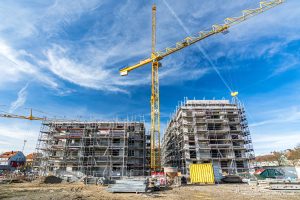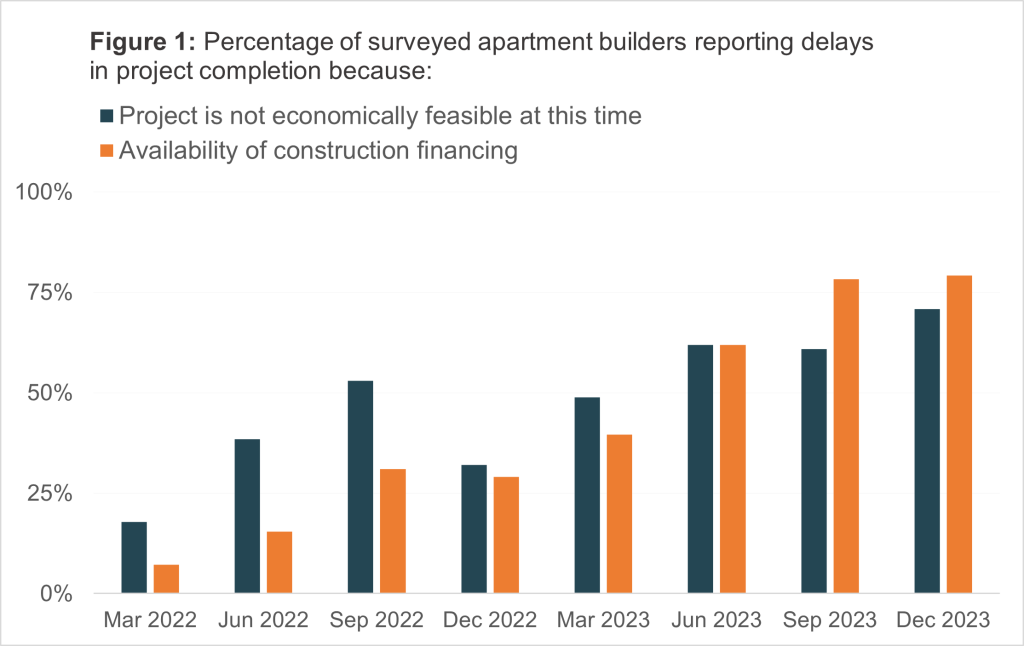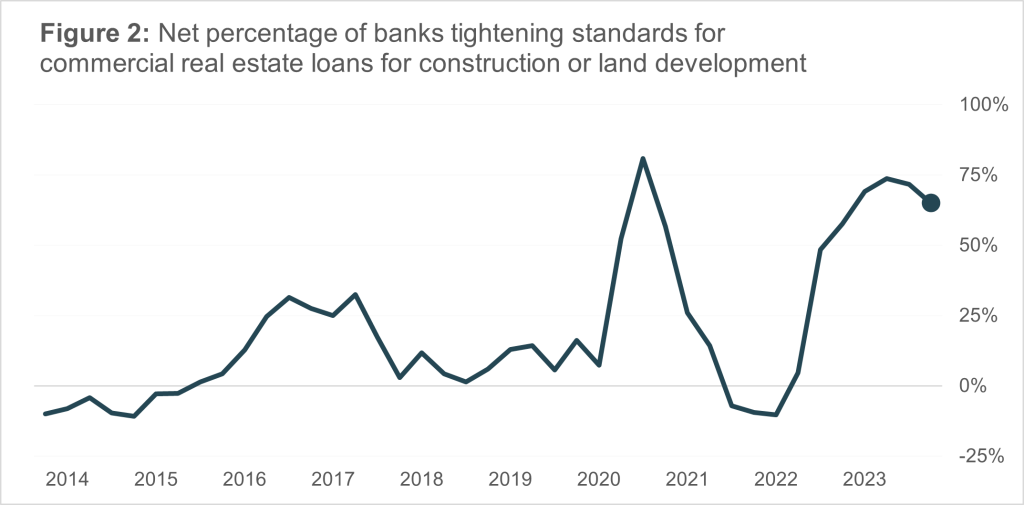|
|
Recent Trends in Real Estate Development: Winter 2024By Frank MuracaPublished February 19, 2024
This blog post is part of a regular series that reports recent trends in private real estate financing. These posts are meant to inform local governments about current conditions facing private developers and development projects in their communities. Lending for real estate development projects Last quarter’s post discussed how rising interest rates affected private developers’ ability to cover debt payments, thereby affecting the financial feasibility of many real estate projects. Real estate market watchers shared cautious optimism that the Federal Reserve may begin to cut rates in 2024 after announcing that rates would remain the same for the third consecutive time in December 2023. However, some economists have said that higher than expected inflation numbers released in January 2024 could delay those rate cuts. In the months leading up to the Fed’s announcement, commercial real estate developers continued to report project delays caused by high interest rates. For example, Kane Realty – a commercial real estate development company – reported that future progress on the mixed-use “Downtown South” project in Raleigh is contingent on “interest rates going down”. According to one survey of the nation’s 30 leading apartment developers, a record 92% of those surveyed reported delays in starts for new projects.[1] Of those delays, 71% were because the project was not economically feasible in December 2023. See Figure 1. In September, 79% of the apartment builders surveyed reported that projects were delayed due to the availability of financing, or loans to pay for the cost of construction. One reason why lending has declined is because lenders have tightened their credit standards. Figure 2 shows survey response data from the Federal Reserve’s Senior Loan Officer Opinion Survey (or SLOOS). The survey asks banks whether they are tightening standards for commercial real estate loans used for construction or land development. While the percentage of banks reporting tightened standards has dropped in the past two quarters, it remains well above pre-COVID levels. According to one analysis from First American Bank, “The percentage of banks reporting tighter lending standards picked up for all types of loans, but this figure was highest for construction loans at 72 percent…This is a complete shift in lending standard trends compared with two years ago, when interest rates were low and banks were reporting looser, rather than tighter standards.” Changes in construction costs In addition to the availability of lending, the cost of building materials continues to be between 30% and 45% higher than pre-COVID prices. In January 2023, one construction company official told WBTV, “COVID really started really inflating prices for construction, for a lot of different materials and that was really the start of it, and now inflation after that has kept prices kind of high, so it’s been probably about 2-years now.” Even with recent reduced inflation, constructions costs have not declined. Taking the long view, the COVID surge in construction prices was the fastest and most significant cost increase since the Federal Reserve started recording this data in 1947.[2] While prices have moderated since their peak in 2022, they remain about 42% above pre-COVID levels. Frank Muraca is a Senior Real Estate Development Analyst with the UNC School of Government’s Development Finance Initiative (DFI). Rory Dowling, DFI Development Advisor, is a co-author of this post. [1] Source: National Multifamily Housing Council. Quarterly Survey of Apartment Construction & Development Activity (December 2023). https://www.nmhc.org/research-insight/nmhc-construction-survey/2023/quarterly-survey-of-apartment-construction-development-activity-december-2023/ [2] St. Louis FRED Economic Data. Producer Price Index by Commodity: Special Indexes: Construction Materials. https://fred.stlouisfed.org/series/WPUSI012011 |
Published February 19, 2024 By Frank Muraca

This blog post is part of a regular series that reports recent trends in private real estate financing. These posts are meant to inform local governments about current conditions facing private developers and development projects in their communities.
Lending for real estate development projects
Last quarter’s post discussed how rising interest rates affected private developers’ ability to cover debt payments, thereby affecting the financial feasibility of many real estate projects. Real estate market watchers shared cautious optimism that the Federal Reserve may begin to cut rates in 2024 after announcing that rates would remain the same for the third consecutive time in December 2023. However, some economists have said that higher than expected inflation numbers released in January 2024 could delay those rate cuts.
In the months leading up to the Fed’s announcement, commercial real estate developers continued to report project delays caused by high interest rates. For example, Kane Realty – a commercial real estate development company – reported that future progress on the mixed-use “Downtown South” project in Raleigh is contingent on “interest rates going down”.
According to one survey of the nation’s 30 leading apartment developers, a record 92% of those surveyed reported delays in starts for new projects.[1] Of those delays, 71% were because the project was not economically feasible in December 2023. See Figure 1.
In September, 79% of the apartment builders surveyed reported that projects were delayed due to the availability of financing, or loans to pay for the cost of construction. One reason why lending has declined is because lenders have tightened their credit standards.
Figure 2 shows survey response data from the Federal Reserve’s Senior Loan Officer Opinion Survey (or SLOOS). The survey asks banks whether they are tightening standards for commercial real estate loans used for construction or land development. While the percentage of banks reporting tightened standards has dropped in the past two quarters, it remains well above pre-COVID levels. According to one analysis from First American Bank, “The percentage of banks reporting tighter lending standards picked up for all types of loans, but this figure was highest for construction loans at 72 percent…This is a complete shift in lending standard trends compared with two years ago, when interest rates were low and banks were reporting looser, rather than tighter standards.”
Changes in construction costs
In addition to the availability of lending, the cost of building materials continues to be between 30% and 45% higher than pre-COVID prices. In January 2023, one construction company official told WBTV, “COVID really started really inflating prices for construction, for a lot of different materials and that was really the start of it, and now inflation after that has kept prices kind of high, so it’s been probably about 2-years now.” Even with recent reduced inflation, constructions costs have not declined.
Taking the long view, the COVID surge in construction prices was the fastest and most significant cost increase since the Federal Reserve started recording this data in 1947.[2] While prices have moderated since their peak in 2022, they remain about 42% above pre-COVID levels.
Frank Muraca is a Senior Real Estate Development Analyst with the UNC School of Government’s Development Finance Initiative (DFI). Rory Dowling, DFI Development Advisor, is a co-author of this post.
[1] Source: National Multifamily Housing Council. Quarterly Survey of Apartment Construction & Development Activity (December 2023). https://www.nmhc.org/research-insight/nmhc-construction-survey/2023/quarterly-survey-of-apartment-construction-development-activity-december-2023/
[2] St. Louis FRED Economic Data. Producer Price Index by Commodity: Special Indexes: Construction Materials. https://fred.stlouisfed.org/series/WPUSI012011
Author(s)
Tagged Under
This blog post is published and posted online by the School of Government to address issues of interest to government officials. This blog post is for educational and informational Copyright ©️ 2009 to present School of Government at the University of North Carolina. All rights reserved. use and may be used for those purposes without permission by providing acknowledgment of its source. Use of this blog post for commercial purposes is prohibited. To browse a complete catalog of School of Government publications, please visit the School’s website at www.sog.unc.edu or contact the Bookstore, School of Government, CB# 3330 Knapp-Sanders Building, UNC Chapel Hill, Chapel Hill, NC 27599-3330; e-mail sales@sog.unc.edu; telephone 919.966.4119; or fax 919.962.2707.




